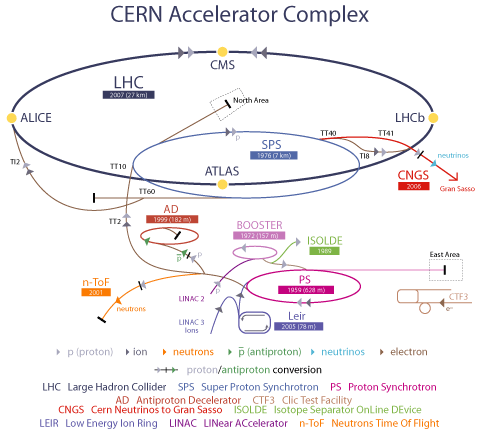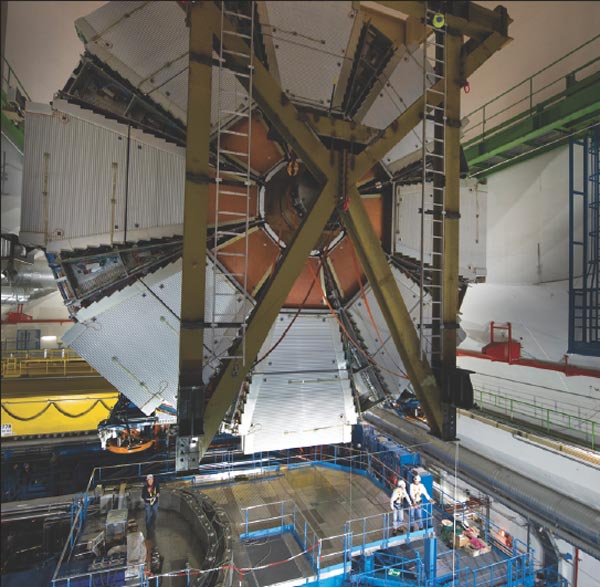General Article -- LARGE HADRON COLLIDER
Mr. Anand P. Kapadia |
The development of the Large Hadron Collider (LHC), the world's largest and most powerful particle accelerator, has involved over 700 Russian physicists from 12 research institutes, a project coordinator said Monday.
CERN in a nutshell
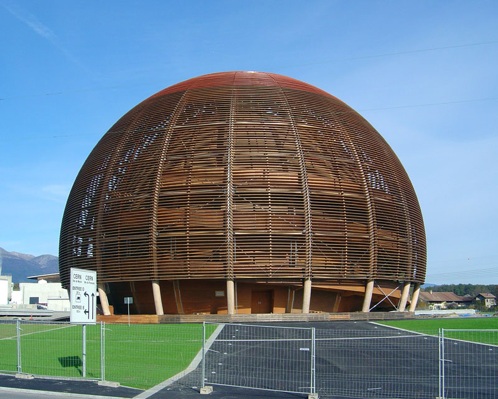
CERN, the European Organization for Nuclear Research, is one of the world’s largest and most respected centres for scientific research. Its business is fundamental physics, finding out what the Universe is made of and how it works.
How the LHC works
The LHC, the world’s largest and most powerful particle accelerator, is the latest addition to CERN’s accelerator complex. It mainly consists of a 27 km ring of superconducting magnets with a number of accelerating structures to boost the energy of the particles along the way.
Inside the accelerator, two beams of particles travel at close to the speed of light with very high energies before colliding with one another. The beams travel in opposite directions in separate beam pipes – two tubes kept at ultrahigh vacuum. They are guided around the accelerator ring by a strong magnetic field, achieved using superconducting electromagnets. These are built from coils of special electric cable that operates in a superconducting state, efficiently conducting electricity without resistance or loss of energy. This requires chilling the magnets to about ‑271°C – a temperature colder than outer space! For this reason, much of the accelerator is connected to a distribution system of liquid helium, which cools the magnets, as well as to other supply services.
Thousands of magnets of different varieties and sizes are used to direct the beams around the accelerator. These include 1232 dipole magnets of 15 m length which are used to bend the beams, and 392 quadrupole magnets, each 5–7 m long, to focus the beams. Just prior to collision, another type of magnet is used to 'squeeze' the particles closer together to increase the chances of collisions. The particles are so tiny that the task of making them collide is akin to firing needles from two positions 10 km apart with such precision that they meet halfway!
All the controls for the accelerator, its services and technical infrastructure are housed under one roof at the CERN Control Centre. From here, the beams inside the LHC will be made to collide at four locations around the accelerator ring, corresponding to the positions of the particle detectors.
The LHC experiments
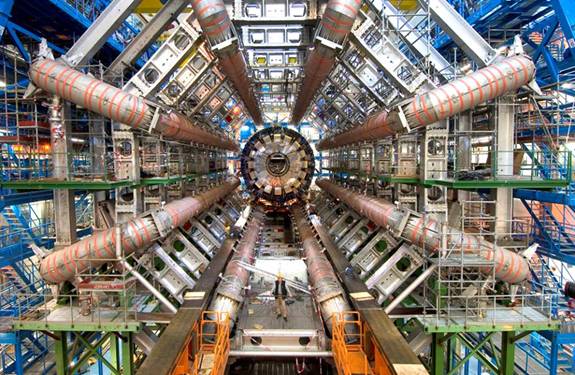
The six experiments at the LHC are all run by international collaborations, bringing together scientists from institutes all over the world. Each experiment is distinct, characterised by its unique particle detector.
The two large experiments, ATLAS and CMS, are based on general-purpose detectors to analyse the myriad of particles produced by the collisions in the accelerator. They are designed to investigate the largest range of physics possible. Having two independently designed detectors is vital for cross-confirmation of any new discoveries made.
Two medium-size experiments, ALICE and LHCb, have specialised detectors for analysing the LHC collisions in relation to specific phenomena.
Two experiments, TOTEM and LHCf, are much smaller in size. They are designed to focus on ‘forward particles’ (protons or heavy ions). These are particles that just brush past each other as the beams collide, rather than meeting head-on.
The ATLAS, CMS, ALICE and LHCb detectors are installed in four huge underground caverns located around the ring of the LHC. The detectors used by the TOTEM experiment are positioned near the CMS detector, whereas those used by LHCf are near the ATLAS detector.
The safety of the LHC
The Large Hadron Collider (LHC) can achieve an energy that no other particle accelerators have reached before, but Nature routinely produces higher energies in cosmic-ray collisions. Concerns about the safety of whatever may be created in such high-energy particle collisions have been addressed for many years. In the light of new experimental data and theoretical understanding, the LHC Safety Assessment Group (LSAG) has updated a review of the analysis made in 2003 by the LHC Safety Study Group, a group of independent scientists.
LSAG reaffirms and extends the conclusions of the 2003 report that LHC collisions present no danger and that there are no reasons for concern. Whatever the LHC will do, Nature has already done many times over during the lifetime of the Earth and other astronomical bodies. The LSAG report has been reviewed and endorsed by CERN’s Scientific Policy Committee, a group of external scientists that advises CERN’s governing body, its Council.
The following summarizes the main arguments given in the LSAG report. Anyone interested in more details is encouraged to consult it directly, and the technical scientific papers to which it refers.
1) Cosmic rays
2) Microscopic black holes
3) Strangelets
4) Vacuum bubbles
5) Magnetic monopoles
Facts and figures
The largest machine in the world...
The precise circumference of the LHC accelerator is 26 659 m, with a total of 9300 magnets inside. Not only is the LHC the world’s largest particle accelerator, just one-eighth of its cryogenic distribution system would qualify as the world’s largest fridge. All the magnets will be pre‑cooled to -193.2°C (80 K) using 10 080 tonnes of liquid nitrogen, before they are filled with nearly 60 tonnes of liquid helium to bring them down to -271.3°C (1.9 K).
The fastest racetrack on the planet...
At full power, trillions of protons will race around the LHC accelerator ring 11 245 times a second, travelling at 99.99% the speed of light. Two beams of protons will each travel at a maximum energy of 7 TeV (tera-electronvolt), corresponding to head-to-head collisions of 14 TeV. Altogether some 600 million collisions will take place every second.
The emptiest space in the Solar System...
To avoid colliding with gas molecules inside the accelerator, the beams of particles travel in an ultra-high vacuum – a cavity as empty as interplanetary space. The internal pressure of the LHC is 10-13 atm, ten times less than the pressure on the Moon!
The hottest spots in the galaxy, but even colder than outer space...
The LHC is a machine of extreme hot and cold. When two beams of protons collide, they will generate temperatures more than 100 000 times hotter than the heart of the Sun, concentrated within a minuscule space. By contrast, the 'cryogenic distribution system', which circulates superfluid helium around the accelerator ring, keeps the LHC at a super cool temperature of -271.3°C (1.9 K) – even colder than outer space!
The biggest and most sophisticated detectors ever built...
To sample and record the results of up to 600 million proton collisions per second, physicists and engineers have built gargantuan devices that measure particles with micron precision. The LHC's detectors have sophisticated electronic trigger systems that precisely measure the passage time of a particle to accuracies in the region of a few billionths of a second. The trigger system also registers the location of the particles to millionths of a metre. This incredibly quick and precise response is essential for ensuring that the particle recorded in successive layers of a detector is one and the same.
The most powerful supercomputer system in the world...
The data recorded by each of the big experiments at the LHC will fill around 100 000 dual layer DVDs every year. To allow the thousands of scientists scattered around the globe to collaborate on the analysis over the next 15 years (the estimated lifetime of the LHC), tens of thousands of computers located around the world are being harnessed in a distributed computing network called the Grid.
LHC Milestones
Journey to a new frontier
The LHC accelerator was originally conceived in the 1980s and approved for construction by the CERN Council in late 1994. Turning this ambitious scientific plan into reality proved to be an immensely complex task.
Civil engineering work to excavate underground caverns to house the huge detectors for the experiments started in 1998. Five years later, the last cubic metre of ground was finally dug for the whole project.
Numerous state-of-the-art technologies were pushed even further to meet the accelerator's exacting specifications and unprecedented demands.
Anticipating the colossal amount of data the LHC's experiments would produce (nearly 1% of the world’s information production rate), a new approach to data storage, management, sharing and analysis was created in the LHC Computing Grid project.
For more than a decade, building the LHC had been a dream for many who have worked hard to bring it to completion. Finally we can retell the story of this adventure in a journey, from a dream to a reality…
LHC finally gets ready for action
Start-up fever
With the world watching the switch-on — even Fermilab in the US will be having a pyjama party to celebrate, with director Pier Oddone allegedly planning to turn up in full nightwear — a lot is riding on a successful day’s work on 10 September. But two “injection tests” that took place last month bode well for the big start-up. These tests are designed to synchronize the LHC with the smaller accelerators that will feed it with protons. On 22 August scientists successfully injected the first protons in the counterclockwise direction of the LHC. This involved using a pulsed magnet to kick small bunches of protons out of the lab’s veteran Super Proton Synchrotron (SPS) and sending them down a 2.7 km-long transfer line towards the LHC. Indeed, scientists even managed to smash protons into a 28 tonne concrete collimator at the entrance to the LHC, which created muons that were detected by the LHCb experiment 200 m along the ring.
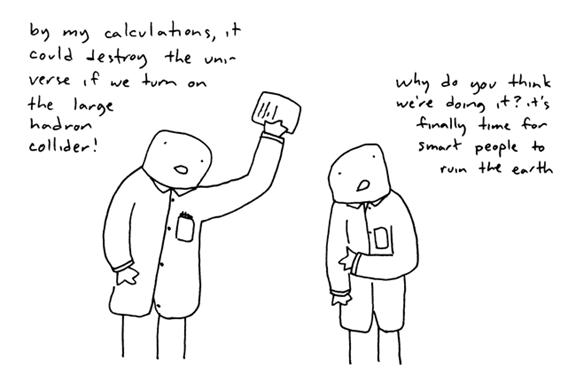
An earlier injection test on 7 August of the clockwise beam also proved successful — indeed, it turned out better than expected. After a few hours spent optimizing the injection process, engineers kicked one bunch of protons out of the transfer line into the LHC, where it travelled about 3 km through one of the LHC’s sectors before being stopped by a screen. “The passage of the beam first time caused some excitement in the control room, and the champagne was rolled out,” machine operator Roger Bailey told PhysicsWorld.
The test was then repeated several times to give the operations team lots of data to help make the start-up as smooth as possible. “The tests could not have gone better,” says CERN spokesperson James Gillies. “There are a lot of very happy people here.”
After nigh-on three decades, scientists at the CERN laboratory near Geneva are on the verge of completing the world’s most powerful particle collider. With all of the 1600 superconducting magnets that will be used to guide protons around the Large Hadron Collider (LHC) having been cooled to 1.9 K, the machine is finally ready to start circulating the first proton beams around its 27 km circumference underground ring.
At 9.30 a.m. local time on 10 September, a team of scientists and engineers will attempt to thread a single, low-intensity bunch of a few billion protons all the way round the €76.3 bn LHC. On the day itself, some 200 journalists from all over the world will be present at CERN to watch events unfold, with live footage of the control room set to be relayed into the lab’s science and innovation “globe”.
The beam will then be passed step by step through each of the LHC’s eight sectors until, by the end of the day, the beam should be fully circulating. After repeating the exercise for protons travelling in the opposite direction around the ring, which could take a further day or so, engineers will then tune the collider’s magnets so that the protons can circulate happily for periods of hours without veering off course.
At some point this autumn, strong focusing magnets will bring the two counter-rotating beams into collision at the LHC’s four interaction points, where the collider’s main experiments are located. If all goes to plan, the LHC will be providing proton–proton collisions at energies of 10 TeV by the end of the year, with a target of 14 TeV by spring next year. Then the real fun starts and the quest to peel back the next layer of nature can begin.
Reference:
www.cern.ch
www.google.com
www.wikipedia.com
